
Until recently little was known about the origins of Greek art: in Greece, the stone age was unknown and only large stone walls are all that remains from that time. These stone walls were named Cyclopean or Pelasgian constructions because the ancient Greeks said they were the work of the first settlers of their country whom they called Pelasgians. Only some naked female idols carved in stone were found with relative abundance in the Aegean islands, all from the Neolithic period.
Cretan civilization refers to the primitive period of continental Greece that in modern times was designated as “pre-Hellenic”. According to the ancient chronicles, the origin of this civilization is placed before the regular development of Greek civilization, which did not begin to manifest until the tenth century BCE. Aegean culture corresponded to a group of civilizations of the Bronze Age that developed in Greece and around the Aegean sea (Crete, the Cyclades, and mainland Greece), and whose most splendid development as a civilization took place on the island of Crete. Now, we know more in detail the historical chronology of the Cretan civilization which began in the Neolithic period, around 3,500 BCE, and that scholars initially called Minoan with reference to the mythical figure of the king Minos who reigned on the island of Crete. Later, after proving the links that that civilization had with the original that flourished in Mycenae, a more appropriate name was given to this Minoan civilization and now it is known as Creto-Mycenaean.
Based on the art that originated and developed in Crete, now the generally accepted chronology for this insular culture comprises the following periods: pre-palatial, which comprises an entirely Neolithic civilization (around 2,500 BCE) and lasted until about the year 2,000 BCE; protopalatial or period of the great palaces (especially important in Phaestos and Knossos) which ran from 2,000 to 1,700 BCE, year in which those buildings were destroyed by a seismic catastrophe; neopalatial or period of the second palaces, from 1,700 to 1,400 BCE, a period of intense reconstruction and cultural peak with traces of other destruction caused by fire, and finally postpalatial, decadent, between 1,400 and 1,100 BCE.


The Minoan civilization was the first fully European ancient culture and until the XVIth century BCE Greece and the islands were subjected to the kings of Crete. It was mainly a maritime culture which spread its cultural influence to Cyprus and the Syrian coast, influenced Phoenician art, and thanks to the old-established trade relations with the Egyptian Empire it managed to bring in the land of the pharaohs its artistic works while the Minoans received artistic Egyptian influence such as small scarab-theme objects. The Minoan civilization was politically based in the existence of small monarchist domains and during the period of its national predominance (between 1,700 and 1,400 BCE) must have acquired the form of a unitary monarchy with capital at Knossos whose palace holds its best artistic examples. Other important architectural remains are in Gournia, the palace of Mallia, and Hagia Triada. These remains of villages or residences were built near the sea -as befitted to the character of maritime power that Crete had- resting on high locations in order to dominate the coast view or to stay away from the dangers posed by a possible invasion. The palaces of Knossos and Phaestos were the two major architectural achievements of the Minoan civilization.

Both buildings imply on their floor plans a concern to follow an axial axis and even during their first post-Neolithic stages they were buildings whose design completely omitted a symmetrical criterion when referring to the spatial location of their rooms. Knossos was a great monumental building lacking (as well as the Palace of Phaestos) forts or any kind of military defense. Built with well squared stones, the Palace of Knossos frequently shows in its chairs representations of the symbol of the double ax and it is possible that its construction was presided by not only the idea of building a palace, but to consecrate it to a divinity (probably female) related to that symbolic weapon. Thus the name that ancient mythology gave to this building labyrinth would come from labrix or ax. The palace also included a room with a marble throne which may have given rise to the legend of Minos as an implacable judge.




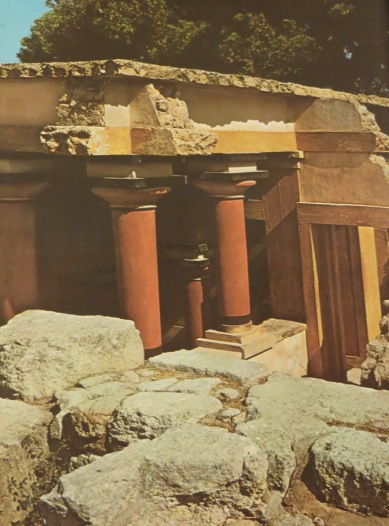
The floor plan of the second palace of Knossos is a labyrinth of corridors and enclosed spaces, which makes it hard to navigate within its numerous chambers and rooms. Some of these rooms are located in a dominant position: after passing through a gate or propylaea they can be reached by a beautiful staircase located in one of the angles and decorated with short columns. These rooms are arranged around a large courtyard of about 50 mt long. There is a long corridor (which has been called The hall of Processions because of a painting depicting a parade whose remains are still visible) and a throne room (as in Phaestos) with a majestic stone chair placed in a prominent place while beautiful frescoes depicting plants and elegantly outlined seated lions adorned the walls. This room opens onto a lobby leading into the courtyard and on the opposite side, through a real loophole of other passages, it is the Queen’s room also decorated with paintings and with an adjacent bathroom. In the lower level there is also another large corridor containing big jars arranged in rows which suggests it must have been a food storage. The palace also had a pavilion as a gazebo equipped with small columns or pillars. The Minoan pillar consisted of a short column with its shaft put upside down, that is, with the widest part in the top and crowned by a capital composed of a narrow ring and a circular molding. The Minoan column was constructed using the trunk of a cypress tree, and while the shafts of most Greek columns were narrower at the top and wider at the bottom to create the illusion of greater height, the Minoan columns are thinner at the bottom and wider at the top, a result of inverting the cypress trunk to prevent sprouting once put in place. This little column must also had the value of a religious symbol. As we will see, the relief that still exists in the Lion Gate at Mycenae‘s walls shows that this particular symbol was also part of the Mycenaean civilization. This sort of pillar of undoubted Cretan origin had a high symbolic meaning when the Achaeans (one of the four major tribes into which the peoples of Classical Greece were divided) had seized Crete. Both emblems, the pillar and the double ax, are represented repeatedly in Minoan frescoes; the double ax appears in many vessels accompanied by floral ornaments and was also repeatedly depicted on top of pedestals.

In Crete there have been found some figurines in terracotta and in finely carved ivory making reference to a cult practiced by young priestesses, perhaps in relation to some underground divinity. These figurines reproduce slender girls with eyes wide open wearing miters and with serpents entwined in their hands. Such young girls wear very tight flared skirts and a kind of open jacket which shows their nude breasts. Other national rite of Minoan Crete that was repeatedly represented in murals involved a daring acrobatic exercise known as “bull leaping”: for the Greeks the Minotaur was already a human monster with a bull’s head: Minos and the bull had been amalgamated into one personality. It is currently believed that Minos was a generic name, a title as it was Pharaoh for the Egyptians; in fact Minos is the Cretan word for “king”. Other several sculptures and frescoes have survived depicting Theseus often as a young boy boxing or jumping. They have very tight waists and lithe and slender bodies that seem built just of nerves and tendons. It is possible that the preference Greeks gave always to the infantry was a strategy inherited from Minoan times. The Greek hoplite* (citizens-soldiers of ancient Greece) barefoot and naked managed to replace the military image of the Persians covered with leather and metal.




Sports were a religious element of the Minoan culture and this fact is confirmed in the floor plan of the Cretan palaces. All services were located in buildings around a huge rectangular courtyard which must served for holidays or bull leaping ceremonies because it included monumental stands for spectators. In the frescoes of Knossos we see the spectators of the preference seats composed exclusively of girls elegantly dressed with small jackets and showing their nude breasts. At the top stand spectators of darker skin, which meant they were composed only by men.
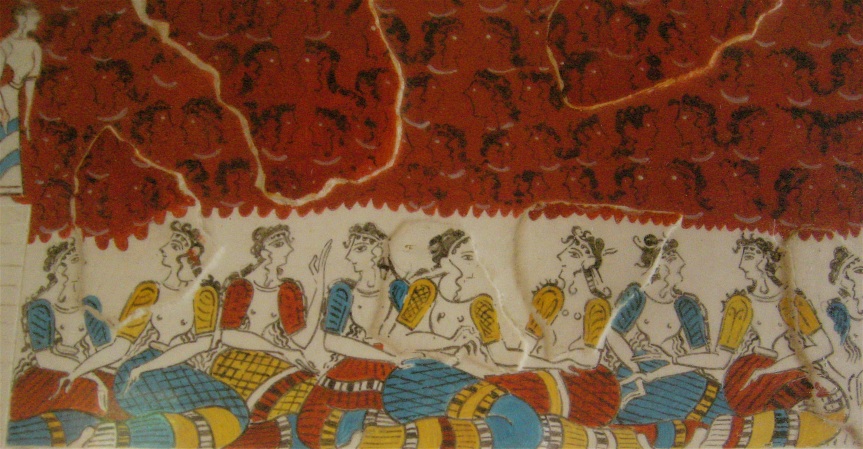

Representations of male figures were not as abundant as that of women, although one of the most beautiful frescoes of Knossos features a male figure. It’s called the Fresco of the Prince, it represents the slender figure of a young beardless man wearing a panache on his head and walking on a red background.
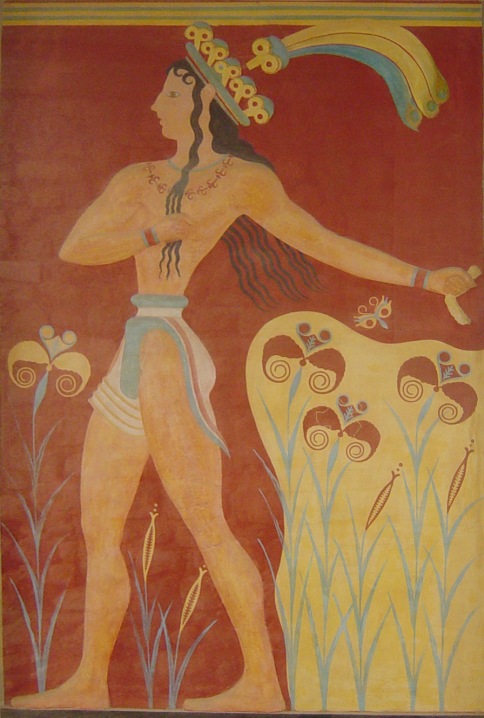
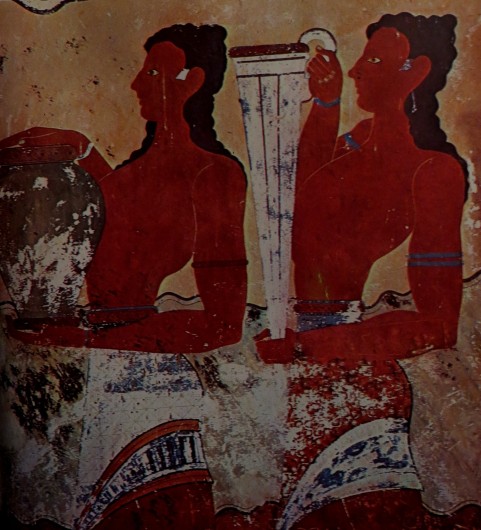


The glyptic, the small sculpture, and the mural painting were very important in the Minoan art. The murals were painted in pure colors: blue, white, red, yellow. The ceramic production was also very important. The ancient ceramic from Kamares (between 1,800 and 1,700 BCE), also abundant in Phaestos, includes great variety of forms: pitchers, concave dishes, crater* shaped vessels, amphorae*…, all of them decorated with rich curve-linear designs that developed into spirals painted in white-on-black background with some hints of vivid hues. From the second palace of Knossos (1,700-1,400 BCE) came other type of pottery more classic in style, usually formed by precious vases and amphorae with small handles. Their painted decoration is usually of plant or marine themes on white or lighter backgrounds. No less important is the so called Gournia ceramic with globular forms and skillful painting of marine animals, mainly octopus, sometimes in combination with algae branches.

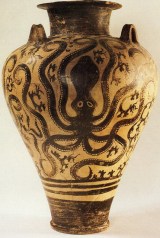

The Minoan art is characteristic for its common representation of animals, particularly marine creatures. Minoan artists expressed their predilection for fish, algae, snails, and dolphins. Behind the throne of Minos in the Palace of Knossos there are seals, the Cretan symbol of power because the seal feeding on fish was seen as the king of the Eastern Mediterranean. Other times the allusion to the power of Minos was represented by the octopus. But alongside these allusions to Minos’ power, glasses, ceramic plates, and frescoes represented simple stems, flowers, and domestic animals.



The maritime empire of Crete was replaced by a hegemony of the kings of Mycenae coming from mainland Greece. The decline in the importance of Crete in pre-Hellenic society and its fusion to the kings of mainland Greece must have begun about 1,400 BCE. Indeed this date is attributed to the destruction and burning of the second palace of Knossos. That was how Greek peoples managed to seize Crete about 1,500 or 1,450 BCE. Such peoples, influenced by the culture of Crete and Peloponnese, developed a fairly uniform cultural and artistic style that in mainland Greece persisted until the new Greek invasion that occurred around the year 1,100. Thus, Minoan and Mycenaean art were amalgamated around 1,500 or shortly thereafter and this fact was proven by a purely cultural fact: the discovery of a kind of “fusion” between Cretan and Mycenaean writings by the archaeologist Arthur John Evans (creator of classical archaeology) who found countless clay tablets during his excavations at Knossos.

________________________________________
 Amphorae: Very large ceramic recipients with two handles and a long narrow neck.
Amphorae: Very large ceramic recipients with two handles and a long narrow neck.
 Crater: A type of large capacity ceramic pot destined to contain a mixture of water and wine.
Crater: A type of large capacity ceramic pot destined to contain a mixture of water and wine.

Hoplite: (From the Greek: hoplitēs; pl. hoplitai). Citizen-soldiers of Ancient Greek city-states who were primarily armed with spears and shields. The word Hoplite derives from hoplon, the name for the type of shield used by the soldiers. However, the shield was more commonly known as an aspis, so the word hopla may refer to the soldiers’ weapons or even their full armament.
 Rhyton: A roughly conical container from which fluids were intended to be drunk or to be poured in some ceremony such as libation, or merely at table. They are typically formed in the shape of an animal’s head, and were produced over large areas of ancient Eurasia, especially from Persia to the Balkans. Many have an opening at the bottom through which the liquid fell; others did not, and were merely used as drinking cups.
Rhyton: A roughly conical container from which fluids were intended to be drunk or to be poured in some ceremony such as libation, or merely at table. They are typically formed in the shape of an animal’s head, and were produced over large areas of ancient Eurasia, especially from Persia to the Balkans. Many have an opening at the bottom through which the liquid fell; others did not, and were merely used as drinking cups.
